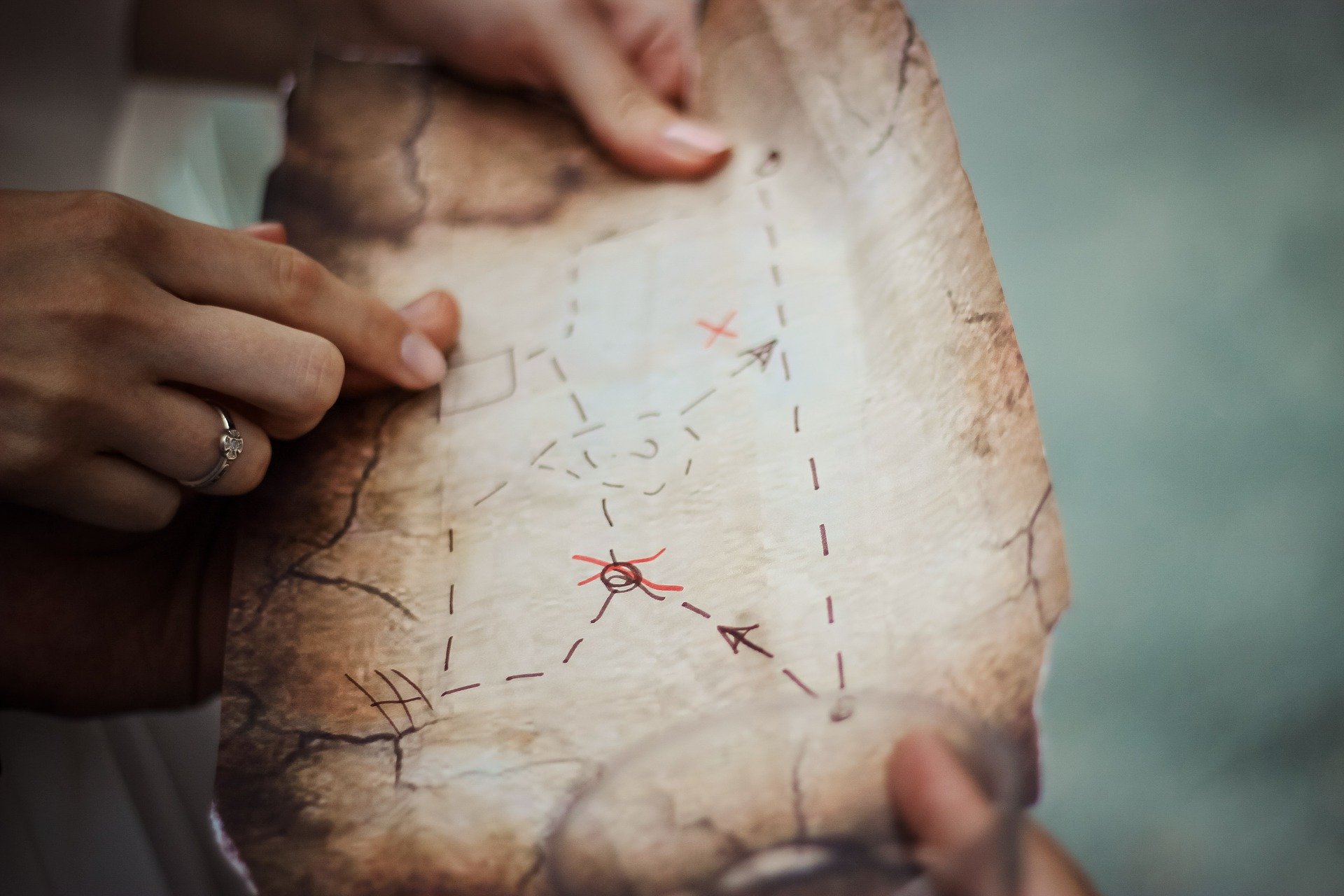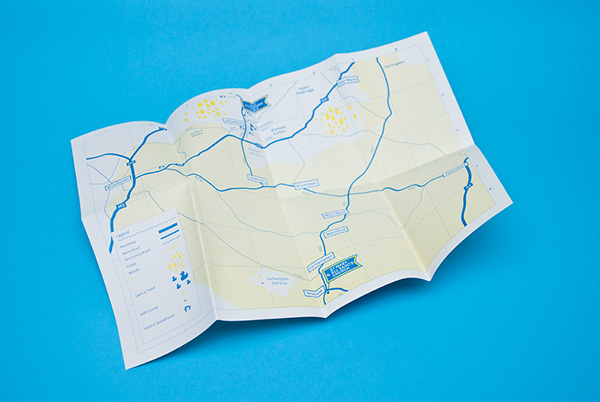My goal for the map exercise, and for most of my poetry prompt making, is to allow students of any level to be able to access this realm of “poetic reality,” to heighten their ability to make associative leaps, to bridge the gap between thinking and feeling in the hopes of sparking language to life.
I have never been adept at using maps for navigation. For a right-brained dyslexic poet prone to dizzy spells, orienting myself in a two-dimensional space while moving through a three-dimensional world can feel like an existential crisis. Still, I have always loved the aesthetics of maps, the craggy shapes and suggestive textures. As a child I admired the abstract perfection of the old-fashioned compass rose I saw on maps dating from the Renaissance and Middle Ages and drew sea monsters to inhabit my own imaginary oceans of darkness. I wanted to create a creature as alive as those invented by the ancient cartographers. I loved the idea of charting the unknown, and the map as a tool of imaginative flight.
Later, wandering through galleries in downtown New York in 2009, I fell in love with poetic maps by the artist Simon Evans. In “Home Country,” Evans took the map of the London Underground and replaced the names of the tube stops with what I consider miniature poems. Some lines feel autobiographical, like “Gran Dad Sells Foam,” while others are more aphoristic, such as “Architects Rectify Their Bodies.” Discovering his work led me to do research into the ways that artists and writers have used maps to create representations of personal experience.
From Madeleine de Scudery’s “Map of Tenderness,” which in 1654 documented a fictional character’s love life, to the artist Grayson Perry’s “Map of an Englishman” (2004), which charted emotional journeys and jokes onto an imaginary landscape of castles and hills, I became enamored with the idea of a map as a kind of poetic self-portrait. The life of the emotions can feel so overwhelming and amorphous, so there’s something appealing about the implied clarity of a map.
During the pandemic, I have pretty much stayed in my Brooklyn apartment, so if I want to have the experience of gazing at an expanse I have to rely on my imagination. Perhaps this is why the poem “Map” by the Brazilian poet Marcos Konder Reis struck me. Often when I am looking for poems to use as prompts, I am drawn to ones with simple structures that could be used in variety of ways. Reis’ poem, with its straightforward map metaphor, the richness of its lists, the way each compass direction combines abstract concepts with concrete imagery, was one that I thought could inspire a multitude of responses.
Recently I attended a virtual workshop by my Rutgers colleague Simone Kearney where she asked the students to take digital photographs of the space they were currently in. This exercise made me realize that one of the advantages of teaching online is that students are at home and thus around objects and places that have meaning to them. I decided to combine Kearney’s focus on objects at home with the map concept and share it with the online generative class I teach for committed, advanced level poets.
I started the exercise by asking the poets to look around their room, write down three objects they noticed, and write a phrase or sentence on a piece of paper describing what they saw. I then asked them to do the same thing while looking out the window or, if a window wasn’t nearby, while looking at pictures on their cell phones. Then I showed them a live cam from Times Square and asked them to write down three to five images from the feed. After that we watched a video of Times Square in a snowstorm. This time, instead of having the poets write their lists down on paper, I asked them to type their lists into the Zoom chat so everyone could see them. I then asked them to look at the words or phrases that the other poets had put in the chat and write down some of the ones that intrigued them.
For the next step I wanted them to imagine moving from the literal world to an emotional/conceptual landscape. I asked them to get an unlined piece of paper and to think of it as a kind of map. (The left side would be west, the bottom south, etc.) Then I invited them to write the words and phrases they had collected onto this new piece of paper, placing each word or phrase where it seemed to belong in this imagined space. For example, I put a phrase I’d written down, “rhinestone on a forehead,” in the top/north quadrant of my paper, and the phrase “gold paper horn” in the left/west side. I told them to feel free to change or excerpt the words and phrases as they transferred them from the paper to the map.
After they’d worked on this for four minutes, I shared the English translation of the Konder Reis poem. I pointed out the phrase “blue map of childhood” and told the poets to imagine their maps representing something abstract like Reis’s concept of “childhood.” Their maps could, like Reis’s, represent a time in their own life, or they could represent the speaker’s love life, the pandemic, failure, the new year, etc. Or they could be maps of a particular emotion, like loss or fear. Whatever they chose, I told them, would help guide them as they wrote their poems, using the structure of Reis’ poem—the idea of East, West, North, and South—as an organizing principle. I encouraged them not to focus too much on the parameters of the prompt, though. I wanted them to use whatever helped them write and ignore whatever got in their way.
The range of work they created surprised me. Some writers stuck closely to the trope of the map and directions, while others interpreted the prompt more loosely. The poets said they liked the way the exercise got them to think about ways of combining the personal space of their apartments with imagery from the very pubic space of Times Square.
All Directions of My Life
—Soodabeh Saeidnia
north, an empty priority box
sitting on a chair with a broken arm
while I’m trying to melt the ice
with grains of salt from the dispenser
south, footprints on the frozen stairs,
slippery ramps and the constant thinking of
“it shouldn’t be there, it shouldn’t be there!”
west has always made me dance
with a cup of dandelion tea in hand
and glistening lip balm on my lips
east but an aftertaste of dried elderberry,
windows hide the joy, granite facades
a long ride with stop signs all the way home
Map of My Fourth Year
—Christine Hamm
My mother’s body floats in the west, limned by the sun. She wears loud blue plastic bracelets, and sits with me, pretending to eat mud pies. We squat together on the grass, the sun so bright it burns us all. I love making her scream when I climb to the top of our willow: I never wear shoes.
In the south, her body changes and she weeps, something is growing inside me. They tell me I will have a sister. I imagine her dark skinned, with many braids. I’ve decided she will be older than me. I kiss my mother’s belly as it swells and swells, grows tight like a drum. She doesn’t like when I slap it to see it tremble like jello.
The old house in the East has dozens of windows, floors, stairways; I linger there once a week so my mother can walk through the woods alone. I play with a sock monkey. There are other, happier children running in and out of the house. An angry Dalmatian curses when I touch his cage. Sometimes it’s a girl in the cage, something wrong with her mouth.
The North: In the north, snow drifts above my head. This is where I throw myself into the street. The snow—marshmallows, clouds, cotton, marshmallows. I stay in the snow until my feet die in rubber boots. Snow clogs roads, seals us in until we smell of animals, and mutter like animals: damn, flower, smile, smile, meat. One of us says, I am so sleepy, curled beneath blankets, huddled and warm.
NYC Driver
—Orly Bendavid
the brooklyn bridge,
the carbon dope,
the watershed trance of endless road
i am always rushing
trying to out drive the sunset
maybe it’s because i still love the radio
my pot bubbles over
the dog wish, someone else’s green grass
the luminary over meserole st facing west
maybe i don’t want to go home
the smell of the apple in my purse
the lunatic rage at the parking ticket
on the dash
the gas pedal
all the way down
i lost my car in industry city today
my fingers almost froze right off
List of Imperatives
—Laurel Kallen
Piano, disagree with the face of your musician.
Disagree.
Or face.
Saturday, wax blue, skip your tech rehearsal.
Skip.
Or wax.
Magnesium tablets, beckon.
Beckon.
Attack the suet cakes, downy woodpecker.
Attack.
Rush across the square, umbrella. Where are all the?
Rush.
Billboard, flash, flash. What else would you do if you?
Do.
Promise, break promise break.
Promise.
Or break.
Fashion the mask. Use flowers.
Mask.
Sweep up the broom of an angel.
Sweep.
Jupiter and Saturn,
you may now kiss the bride you may now kiss the
kiss.
Or kiss.
Yard
—Kate Lutzner
You were napping then, while I wrote.
Objects circled the room,
grapes and voodoo necklaces, the color
yellow, a sleeping bag no one had used
for enough years that a child might emerge,
fresh as leaves or an empty computer
screen. The pigeon referenced
your childhood, where you wore
a floral face mask before it was fashionable,
before anyone was dying of germs.
And out the window, a snow globe.
Germs, again, but mostly snow.
A snowed-over bonfire where we had roasted
marshmallows last winter. I had a picture
in my mind of what it meant to be
outside again, in the early morning.
I wanted you to be only
happy, and for me to be only
happy. I wanted for us to be super-
heroes for each other, a word
you’d said earlier and I’d taken note
of it. I wanted the striped advertisement
in Times Square to mean something,
especially in this era where everyone
was dying, where we had passed a friend
of yours on the trail this morning
and her friend had just died, and a friend
of that friend had just died. Everything
was circling around the pigeon
and the cloud, even the dirt
from the ground was circling, hitting
our masked faces. The last thing I saw
before we fell into each other
was the purple cigarette lighter
from your dresser, carved
out of the eighties, thick
in our hands.
What I find interesting, reading these poems, is how the imagery of the webcam footage (the snow, the billboard, the mask and the ice) is transformed into personal landscapes. These are clearly poems of the pandemic moment (they all capture our current anxiety in different ways), but none of them mimics the clichés of the moment. The exercise encourages what Robert Bly refers to as “poetic leaping” or “the ability to associate fast.” As Bly explains it, “The considerable distance between associations, the distance the spark has to leap, gives the lines their bottomless feeling, their space, and the speed of the association increases the excitement of the poetry.” Or, as Pierre Reverdy explained it years earlier, “The image is a pure creation of the mind. It cannot be born from a comparison but from a juxtaposition of two more or less distant realities. The more the relationship between the two juxtaposed realities is distant and true, the stronger the image will be—the greater its emotional power and poetic reality.” The purpose of encouraging writers to incorporate images from the domestic and public sphere is to encourage this sort of lively juxtaposition.
When I teach this exercise again, I might swap out the Reis poem for “Island on Earth” by the Uruguayan poet Sara de Ibáñez. (Or I might teach them both together.) I think the Ibanez poem would work better for students who are less seasoned because the imagery is more concrete and appeals more to the five senses.
This lesson could also be adapted for younger students or less experienced writers. I would start the lesson the same way, asking students to write down objects they notice in their spaces, out the window and in the videos. I would also give them a little more direction for the types of things to look for in their private spaces, telling them to think of their eye as a camera with a “close up lens” to find something smaller than a quarter for their list of images, or something that no one else would think of as significant. I’d remind them that sometimes things that don’t feel “poetic” can become magical within a poem. When they watch the video, I would ask them to describe the smells or sounds of the scene in addition to describing visual images.
After the students gather their lists of words and place them on an imaginary map, I would have them read “Island on Earth.” Then, before they started on their own poems, I’d ask the students to name something—an idea or emotion—the map might be a guide to, a map of loneliness, for instance, or, for younger students, a map of silliness. I’d ask the students to use the words and phrases they wrote down on their map, inviting them to use the structure of Ibáñez’s poem so the first line would start, “In the North…” I’d also stress, though, that if their imagination takes them in another direction, that’s okay too. I would tell them that the goal is to create a poem a reader can enter, like a space, and to think about how their words can create not only a picture but a three-dimensional tactile experience of what their emotions or ideas feel like.
My goal for the map exercise, and for most of my poetry prompt making, is to allow students of any level to be able to access this realm of “poetic reality,” to heighten their ability to make associative leaps, to bridge the gap between thinking and feeling in the hopes of sparking language to life.
Joanna Fuhrman is an Assistant Teaching Professor in Creative Writing at Rutgers University and the author of seven books of poetry, including To a New Era (Hanging Loose Press, 2021) and the forthcoming Data Mind (Curbstone/Northwestern University Press, 2024). Fuhrman's poems have appeared in Best American Poetry 2023, The Pushcart Prize anthology, The Academy of American Poets' Poem-a-Day, and The Slowdown podcast. She first published with Hanging Loose Press as a teenager and became a co-editor in 2022.





One response to “The Map as Metaphor”
[…] Posted on January 27, 2022 by Soodabeh The Map as Metaphor: Poetic Cartographies in the Virtual Classroom […]